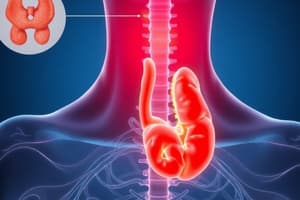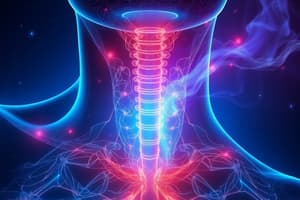Podcast
Questions and Answers
What characteristic helps to distinguish follicular carcinoma from follicular adenoma?
What characteristic helps to distinguish follicular carcinoma from follicular adenoma?
- High levels of calcitonin
- Loss of neuroendocrine features
- Presence of amyloid deposits
- Invasion through the fibrous capsule (correct)
What happens to serum calcium levels as a result of high calcitonin levels produced by medullary carcinoma?
What happens to serum calcium levels as a result of high calcitonin levels produced by medullary carcinoma?
- Hypercalcemia occurs due to increased renal calcium excretion
- Hypocalcemia occurs due to increased renal calcium excretion (correct)
- Serum calcium levels remain unchanged
- Hypocalcemia occurs due to increased bone resorption
What is a common effect of anaplastic carcinoma on the patient?
What is a common effect of anaplastic carcinoma on the patient?
- Increased calcitonin secretion
- Difficulty swallowing or respiratory issues (correct)
- Significant weight gain
- Improved overall prognosis
What genetic mutation is commonly associated with familial cases of medullary carcinoma?
What genetic mutation is commonly associated with familial cases of medullary carcinoma?
What characteristic finding might a biopsy of medullary carcinoma reveal?
What characteristic finding might a biopsy of medullary carcinoma reveal?
What is a potential complication of thyroid storm?
What is a potential complication of thyroid storm?
Which treatment is specifically indicated for managing thyroid storm?
Which treatment is specifically indicated for managing thyroid storm?
What distinguishes a toxic multinodular goiter from a nontoxic one?
What distinguishes a toxic multinodular goiter from a nontoxic one?
Which condition is characterized by hypothermia and weight loss despite an increased appetite?
Which condition is characterized by hypothermia and weight loss despite an increased appetite?
Which is NOT a cause of hypothyroidism in older children and adults?
Which is NOT a cause of hypothyroidism in older children and adults?
What is the hallmark feature of myxedema?
What is the hallmark feature of myxedema?
What is the role of thyroid hormone in early pregnancy?
What is the role of thyroid hormone in early pregnancy?
Hashimoto thyroiditis is associated with which genetic marker?
Hashimoto thyroiditis is associated with which genetic marker?
What is the primary characteristic of a thyroglossal duct cyst?
What is the primary characteristic of a thyroglossal duct cyst?
Which of the following is not a clinical feature of hyperthyroidism?
Which of the following is not a clinical feature of hyperthyroidism?
In Graves' disease, what is the main cause of the increased synthesis and release of thyroid hormones?
In Graves' disease, what is the main cause of the increased synthesis and release of thyroid hormones?
What is a common initial clinical presentation of hypothyroidism due to follicle damage?
What is a common initial clinical presentation of hypothyroidism due to follicle damage?
Which characteristic is associated with subacute granulomatous thyroiditis?
Which characteristic is associated with subacute granulomatous thyroiditis?
What laboratory finding is typically associated with hyperthyroidism?
What laboratory finding is typically associated with hyperthyroidism?
Which feature distinguishes Riedel fibrosing thyroiditis from anaplastic carcinoma?
Which feature distinguishes Riedel fibrosing thyroiditis from anaplastic carcinoma?
What histological feature is associated with Graves' disease?
What histological feature is associated with Graves' disease?
Which of the following symptoms is characteristic of hyperthyroidism?
Which of the following symptoms is characteristic of hyperthyroidism?
What finding would most likely indicate a malignant thyroid nodule?
What finding would most likely indicate a malignant thyroid nodule?
Which of the following is a significant risk factor for developing papillary carcinoma?
Which of the following is a significant risk factor for developing papillary carcinoma?
What underlying mechanism contributes to exophthalmos in Graves' disease?
What underlying mechanism contributes to exophthalmos in Graves' disease?
What histological feature is characteristic of papillary carcinoma?
What histological feature is characteristic of papillary carcinoma?
Which of the following is not a feature of the thyroid gland's embryonic development?
Which of the following is not a feature of the thyroid gland's embryonic development?
What typically describes the prognosis of papillary thyroid carcinoma?
What typically describes the prognosis of papillary thyroid carcinoma?
What is the primary histological characteristic of follicular adenoma?
What is the primary histological characteristic of follicular adenoma?
Flashcards
Thyroid Storm
Thyroid Storm
A potentially fatal complication of hyperthyroidism, often triggered by stress like surgery or childbirth.
Hashimoto Thyroiditis
Hashimoto Thyroiditis
Autoimmune destruction of the thyroid gland, often associated with HLA-DR5.
Cretinism
Cretinism
Hypothyroidism in neonates and infants, characterized by mental retardation, short stature, and other developmental issues.
Myxedema
Myxedema
Signup and view all the flashcards
Multinodular Goiter
Multinodular Goiter
Signup and view all the flashcards
Dyshormonogenetic Goiter
Dyshormonogenetic Goiter
Signup and view all the flashcards
Hyperthyroidism
Hyperthyroidism
Signup and view all the flashcards
Propylthiouracil (PTU)
Propylthiouracil (PTU)
Signup and view all the flashcards
What is Follicular Carcinoma?
What is Follicular Carcinoma?
Signup and view all the flashcards
What is Medullary Carcinoma?
What is Medullary Carcinoma?
Signup and view all the flashcards
What is Medullary Carcinoma linked to?
What is Medullary Carcinoma linked to?
Signup and view all the flashcards
What is Anaplastic Carcinoma?
What is Anaplastic Carcinoma?
Signup and view all the flashcards
Can FNA distinguish between follicular adenoma and follicular carcinoma?
Can FNA distinguish between follicular adenoma and follicular carcinoma?
Signup and view all the flashcards
Thyroglossal duct cyst
Thyroglossal duct cyst
Signup and view all the flashcards
Lingual thyroid
Lingual thyroid
Signup and view all the flashcards
Graves' disease
Graves' disease
Signup and view all the flashcards
Diffuse goiter
Diffuse goiter
Signup and view all the flashcards
Exophthalmos
Exophthalmos
Signup and view all the flashcards
Pretibial myxedema
Pretibial myxedema
Signup and view all the flashcards
Type II hypersensitivity
Type II hypersensitivity
Signup and view all the flashcards
Subacute Granulomatous Thyroiditis
Subacute Granulomatous Thyroiditis
Signup and view all the flashcards
Riedel Fibrosing Thyroiditis
Riedel Fibrosing Thyroiditis
Signup and view all the flashcards
Follicular Adenoma
Follicular Adenoma
Signup and view all the flashcards
Papillary Carcinoma
Papillary Carcinoma
Signup and view all the flashcards
Hot thyroid nodule
Hot thyroid nodule
Signup and view all the flashcards
Cold thyroid nodule
Cold thyroid nodule
Signup and view all the flashcards
Fine needle aspiration (FNA)
Fine needle aspiration (FNA)
Signup and view all the flashcards
Study Notes
Thyroglossal Duct Cyst
- A cystic dilation of a thyroglossal duct remnant
- The thyroid develops at the base of the tongue, then moves down the thyroglossal duct to the anterior neck
- The duct usually disappears, but a persistent duct can form a cyst
- Presents as a neck mass
Hyperthyroidism
- Increased levels of circulating thyroid hormone
- Increased basal metabolic rate (due to increased Na+-K+ ATPase synthesis)
- Increased sympathetic nervous system activity (due to increased B₁-adrenergic receptor expression)
- Clinical features include weight loss despite increased appetite, heat intolerance and sweating, tachycardia with increased cardiac output, arrhythmia, tremor, anxiety, insomnia, heightened emotions, staring gaze with lid lag, diarrhea, oligomenorrhea, bone resorption with hypercalcemia (risk for osteoporosis), decreased muscle mass with weakness, hypocholesterolemia, and hyperglycemia
Graves' Disease
- An autoimmune disease (IgG stimulates TSH receptor)
- Leads to increased thyroid hormone synthesis and release
- Most common cause of hyperthyroidism
- Commonly affects women of childbearing age (20-40 years)
- Clinical features include hyperthyroidism, diffuse goiter, exophthalmos, and pretibial myxedema
Lingual Thyroid
- Persistence of thyroid tissue at the base of the tongue
- Presents as a base of tongue mass
Multinodular Goiter
- Enlarged thyroid gland with multiple nodules
- Due to relative iodine deficiency
- Usually nontoxic (euthyroid)
- Rarely, regions become independent of TSH, leading to T4 release and hyperthyroidism (toxic goiter)
Hypothyroidism: Cretinism
- Hypothyroidism in newborns and infants
- Characterized by mental retardation, short stature, skeletal abnormalities, coarse facial features, enlarged tongue, umbilical hernia
- Thyroid hormone is essential for brain and skeletal development
- Causes include maternal hypothyroidism during pregnancy, thyroid agenesis, dyshormonogenetic goiter, and iodine deficiency
Hypothyroidism: Myxedema
- Hypothyroidism in older children or adults
- Clinical features include decreased basal metabolic rate, decreased sympathetic nervous system activity, myxedema (accumulation of glycosaminoglycans in skin and soft tissue), weight gain despite normal appetite, slowed mental activity, muscle weakness, cold intolerance, bradycardia, decreased cardiac output (leading to shortness of breath and fatigue), oligomenorrhea, and hypercholesterolemia
Hashimoto's Thyroiditis
- Autoimmune destruction of the thyroid gland
- Most common cause of hypothyroidism in areas with adequate iodine
- Initially presents with hyperthyroidism then progresses to hypothyroidism
- Antithyroglobulin and antithyroid peroxidase antibodies are often present
- Chronic inflammation, germinal centers, and Hurthle cells (eosinophilic metaplasia) seen on histology
- Increased risk for B-cell lymphoma
Subacute Granulomatous (De Quervain) Thyroiditis
- Granulomatous thyroiditis following viral infection
- Presents as a tender, enlarged thyroid with transient hyperthyroidism
- Usually self-limited; rarely progresses to hypothyroidism
Riedel Fibrosing Thyroiditis
- Chronic inflammation resulting in extensive thyroid fibrosis
- Presents as hypothyroidism with a hard, nontender thyroid
- Fibrosis may involve surrounding structures
- Usually not malignant, but can mimic anaplastic carcinoma
Thyroid Neoplasia
- Thyroid nodules are often benign
- Radioactive iodine uptake studies help differentiate benign and malignant nodules
- Increased uptake suggests Graves' or nodular goiter
- Decreased uptake suggests adenoma or carcinoma, requiring biopsy
- Fine-needle aspiration (FNA) is used for biopsy
Papillary Carcinoma
- Most common thyroid cancer (80%)
- Exposure to ionizing radiation is a risk factor
- Papillae, clear "Orphan Annie" nuclei, and nuclear grooves
- Often spreads to cervical lymph nodes but has good prognosis (10-year survival >95%)
Follicular Carcinoma
- Malignant proliferation of follicles
- Invasion of the capsule helps distinguish it from follicular adenoma
- Entire capsule must be examined microscopically
- Metastasis usually occurs hematogenously
Medullary Carcinoma
- Malignant proliferation of parafollicular C cells, comprising 5% of thyroid cancers
- C cells produce calcitonin
- High levels of calcitonin can lead to hypocalcemia; detected by biopsy
- Familial cases frequently associated with MEN 2A or 2B (mutations in RET oncogene)
Anaplastic Carcinoma
- Undifferentiated malignant thyroid cancer
- Usually arises in elderly patients
- Locally invasive, often causing dysphagia or respiratory problems
- Poor prognosis
Studying That Suits You
Use AI to generate personalized quizzes and flashcards to suit your learning preferences.
Related Documents
Description
This quiz covers key concepts related to the thyroglossal duct cyst, hyperthyroidism, and Graves' Disease. Understand the development and implications of these conditions, their clinical features, and effects on the body. Test your knowledge on the endocrine system's complexities and related disorders.




